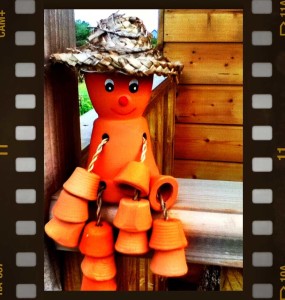 There’s something about Willow that fascinates me, mainly because of its many uses. I love the idea of multi-tasking plants or trees and Willow is one of those that can be grown for craftwork as well as fuel, and it looks good too!
There’s something about Willow that fascinates me, mainly because of its many uses. I love the idea of multi-tasking plants or trees and Willow is one of those that can be grown for craftwork as well as fuel, and it looks good too!
GROWING WILLOW
I hope that one day I will be growing willow to fuel our wood burning stove but I need to learn more about this and find out the best place to source the willow and correct type etc. In the mean time I have been focusing on willow weaving as I want to learn how to make a living fence.
IRISH SEED SAVERS
I already have a couple of willow trees near the house and I hope to make use of their speedy growth throughout the garden. So I took my first step in this direction last weekend by attending a course in willow weaving up in Irish Seed Savers in County Clare.
This really is a wonderful place to visit and in addition to holding various workshops and open days throughout the year they do the vitally important work of saving seeds.
Without this many of the seeds and plants which form part of our heritage may disappear forever! You see right now corporations are rushing around the globe greedily sucking up seed patents, modifying seeds into generic money spinners, while at the same time pushing for laws which make it illegal to save seeds! See how that works?
Anyway, that’s my rant for the day over so let’s get back to willow. The teacher was Mark Wilson and the workshop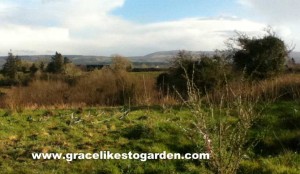 was held in this beautiful field. In a typically west of Ireland manner this is a field that cleverly hides its boggy nature from you until you find yourself ankle-deep in mud. We soon forgot about the mud as Mark was a great teacher and had a way of imparting information that made you learn more than you realised at the time. He was competing against the wind and the rain and even so he managed to keep our interest with his easy-going manner and sense of humour.
was held in this beautiful field. In a typically west of Ireland manner this is a field that cleverly hides its boggy nature from you until you find yourself ankle-deep in mud. We soon forgot about the mud as Mark was a great teacher and had a way of imparting information that made you learn more than you realised at the time. He was competing against the wind and the rain and even so he managed to keep our interest with his easy-going manner and sense of humour.
GRADING WILLOW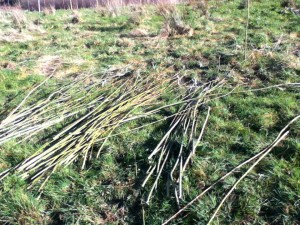
We began by grading willow into different sizes/species to make it easier to weave with and to make the resulting fence look better too.
WILLOW BED
Then we learned to make our willow bed. To do this you cover your strip of ground with carpet or weed-cover/mipex or cardboard. Mark showed us how to dig in, or tuck in the mipex. This method worked really well on the soft ground with not a pin or a rock needed to hold it in place. Mark had a nifty way of working the fabric around curves as well – by folding it over.
- Tucking In The Mipex
- Folding Mipex Around Corner
- Mipex – All Tucked In
THE SPIKE
At this point Mark introduced us to the ‘spike.’ I knew about this tool already as I had 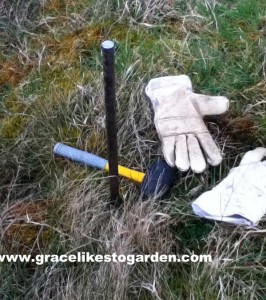 read that it was handy for making the rod-shaped holes necessary to plant the willow. However, I had searched in many local shops with no success and I had resorted to using a crowbar and poker with little success. I asked Mark where he got his and he told me he made it himself in his forge in Mountshannon. More about the ‘spike’ here.
read that it was handy for making the rod-shaped holes necessary to plant the willow. However, I had searched in many local shops with no success and I had resorted to using a crowbar and poker with little success. I asked Mark where he got his and he told me he made it himself in his forge in Mountshannon. More about the ‘spike’ here.
We didn’t really need the spike in the soggy Clare field as the rods were easily pushed into the soft soil. However, it is a much-needed tool in my rocky poor-soiled garden.
BUDS SHOULD LOOK AT THE SKY
We cut the rods into 12 inch lengths and used loppers to make a slanted cut. We also learned to make sure that bud growth was facing the sky, otherwise you might plant them upside down – something I admit I probably wouldn’t have thought about as the buds are tiny.
We planted the 12 inch long willow rods 12 inches apart (easy to remember.) They are planted close and will be cut back every year to 12 inches and each little side-shoot should be removed close to the rod to promote further growth.
WILLOW WEAVING
The next task was to plant long (up to 6ft) rods of willow to make a living fence and I think the pictures below show the process more clearly than I can every fully explain!
- Criss-cross Willow rods
- Weaving The Tops Down
- Willow Arch
By the end of the day we had created a full living willow fence as well as an arched entrance. It was fun work especially since we were seeing such fast results.
After the course I met up with hubby who had enjoyed his course in bee-keeping – also in Seed Savers.
It really was a great day and a big thank you to Irish Seed Savers for putting on this great course and for saving our seeds!
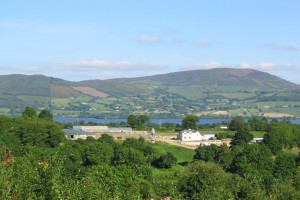









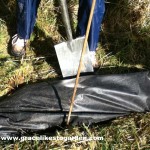

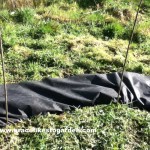

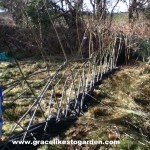

Recent Comments